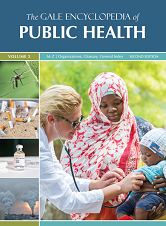About Secondary Data
How do demographic characteristics, such as culture, age, ethnicity, and gender, along with socioeconomic status, education levels, family structures, healthcare access, and transportation, affect or influence healthcare outcomes and delivery within a community?
To explore this question, search for secondary data that highlights these factors and their impact on healthcare. Use relevant terms and explore a variety of types of resources. Government agencies, associations, and organizations often publish data, primary source documents, and articles in journals or on the Web. For regional insights, use geographic terms, such as city names (e.g., Tulsa, Inola), or Zip codes in your searches.
Types of secondary data may include:
- Demographics - population, gender, ethnic group, migration trends, urban/rural distribution, community characteristics, age, education level, household income, economic level, geographic data/location
- Socioeconomic and Environmental Data
- Health Data - mortality rates, immunization rates, access to health services, facility-to-population ratio
- Sociocultural Factors - customs, education, family structure, language, neighborhood dynamics, politics, social interactions (e.g., peer relationships), technology use, and cultural values
- Religious/Spiritual Factors - affiliations, beliefs, and traditions
In addition to the websites and sample results listed in this guide, search the web for your specific area or population group along with the data or statistics you need. To ensure relevant and reliable results, try to limit your search to government documents and official sources.
Examples:
your concept(s) and location and site:.gov
health and Tulsa and demographic
Teshi Accra and (demographic or population) and site:.gov
About Demographic Resources & Keyword Searching
Demographic Resources
Demographic data can be found in a variety of resources, including news and database articles, government resources, and websites.
Company, business, and news websites may provide some narrower demographics of a larger community, the mission or vision statement, purpose, information on the physical environment, services, beliefs, community composition and more
Example:
- opens new windowThe American Airlines Newsroom website, posted American Airlines has more than opens new window5,500 team members at their Tulsa base (2020).
- opens new windowHospice of Green Country website
- opens new windowInnovative Family Wellness (IFW) website
Charitable and non-profit organization websites may provide the philosophy, leadership, purpose, program(s) and more.
Examples:
- opens new windowGood Samaritan Health Services.
- opens new windowJust the Beginning
- opens new windowXavier Medical Clinic
Government sites contain a variety of data, including demographics for specific areas and people groups.
Examples:
- Government information can be found tabulated on documents and websites, such as Supporting Veterans in Oklahomaopens new window by Veterans Data Central.
- opens new windowTulsa Police Department (See also: opens new windowCityData > Tulsa > Police [CTRL+F].)
- opens new windowTulsa Vet Center
- The U.S. Census Bureau provides infographics for opens new windowVeteran Statistics: Oklahoma, opens new windowU.S. Census Bureau: Veterans, or see the opens new windowNational Center for Veterans Analysis and Statistics (U.S. Department of Veterans Affairs).
Healthcare and government health department websites include surveys, vital statistic reports, health outcomes, behavioral factors and more.
School data and demographics can be gleaned from government regional, education, and nonprofit sites. Check out the resources listed on the "Nonprofit Organizations and Businesses" and "Regional Statistics and Data" tabs.
Keyword Searching
Use relevant words for a general topic or specific concept when searching a database, the web, or prompting AI tools.
Examples:
- physical environment; climate; spaces, land
- demographic, age, race, ethnicity, sex, marital status, trends, morbidity & mortality
- politics, travel/transportation, boundaries; community threats, disasters
- culture, society, socio-cultural, social environment, characteristics
- statistic, data, overview
- trends, community environment, growth, decline, expansion, weakness
Sample searches, articles and web documents are provided on this guide to help students navigate and explore resources relevant to the assignment and target communities. View sample resources and search examples on these pages, then edit to match your research needs.
-
Comprehensive Community Assessment Tool (EICAT)Assignment for NUR-403, Patterns of Community Health.
Featured Resources
-
Community Health Nursing: Caring for the Public's Health, 3rd ed. byCall Number: RESERVEISBN: 9781449687168Publication Date: 2014
-
American Indian Health and Nursing by
Call Number: EbookISBN: 9781786848130Publication Date: 2015
Selected Journal Articles:
• opens new windowCommunity Health Nursing through a Global Lens
• opens new windowApproaches to Community Nursing Research Partnerships: A Case Example
• opens new windowExpertise in Action: Insights into the Dynamic Nature of Expertise in Community-based Nursing
-
 The Gale Encyclopedia of Public Health
by
Call Number: EbookISBN: 9780028666709Publication Date: 2019
The Gale Encyclopedia of Public Health
by
Call Number: EbookISBN: 9780028666709Publication Date: 2019
Search Authoritative Websites & Government Statistics
Search for and restrict results to government and association or organization data. As shown in the chart below, limit to domain .gov (site:.gov) for government sites, or add the term association or organization to your search expression.

